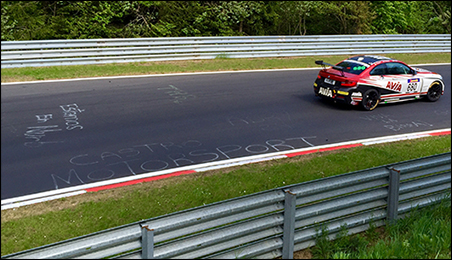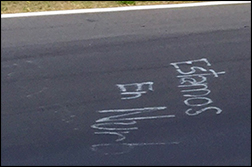There’s an old saying that says you should always look at the writing on the wall, because that’s where you’ll find what you truly need to know. During my most recent Nordschleife visit, to attend the third VLN-race of 2016, I learned that the wall isn’t the only place where you should look for interesting writing. The race track is another one.

Anyone who has ever visited the Nordschleife knows that it’s a bit different from other race tracks. Where modern circuits boast about how smooth and clean their asphalt is, the asphalt at the Nordschleife is covered in, well… basically anything and everything, really. The complete length of the track is covered in graffiti, mostly done in white spray-paint, but black, yellow, and red are popular colours too. I think I once read somewhere that initially the Nordschleife owners had the asphalt cleaned every time a new message appeared, but when the graffiti just kept coming and coming they eventually gave up and let the writings be.
Over the past few decades, anonymous people have covered the Nordschleife in a diverse array of messages. Some stick to egocentric phrases (“X was here”), while others praise their home town (“city Y is the best”) or showcase their business data (“Check Youtube @ZZZZZZ”); while again others use the opportunity to put their artistic talents for drawing boobs and genitals on display. Most messengers will leave their words on the track itself, but over the years catch fences and curbstones have also become popular writing surfaces.
When I’m trackside, I rarely pay attention to the writings. I quickly got used to them and came to accept them as part of the scenery; the background. I think it works that way for most people. It gives you a better chance to focus on the cars and the ongoing races. However, during VLN3 I suddenly found myself distracted by three words, written on the asphalt at the entrance of the Galgenkopf: “Estamos en Nurb”.

The words are Spanish for “We’re at the Nurb”. They’re painted in bright white paint with the exception of the final letter B, which is white-greyish in colour and half faded away. The message caught my eye, because it seemed so unfinished. Surely the messenger had been aiming for “We’re at the Nurburgring”. But if so, why didn’t he finish? Did something happen to distract him? For the first time ever I found myself wondering where the Nordschleife messages come from exactly. Do the messengers climb onto the track at night? Or do they do their work during the day, when they think the Ring is (temporarily) closed to car rides? Is it possible then that this particular author was surprised by the sound of an oncoming car and had to make a dash for safety? Or was he chased away by an official? Or was he perhaps so intoxicated at the time of writing that he forgot how to spell ‘Nurburgring’ and simply figured ‘oh sod all this, I’m going home’?
As with many other things related to the Nordschleife, the message will forever hold an element of mystery. It’s a shame really, because it seems like an interesting tale that I would love to know; but at the same time it’s also okay. The Ring is such a special place, it can handle a little bit of mystique here and there. In fact, it’s probably the better for it. But still, the mind can always wonder.
